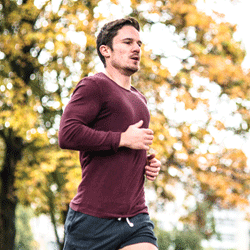So you’ve decided to do ‘Couch to 5k’. Brilliant and well done. This has become a popular challenge in recent years and is presented is an easy to use ‘App’ format. It’s responsible for helping a lot of people get off their arses and get active, and so it should be applauded. Training is gradually progressed over time and uses a blend of walking, jogging and running over different distances. Despite being carefully planned out, we can still see a number of people getting injured when attempting this chellenge and training programme. Many of the injuries are ‘overuse’ in nature. So what can be done to help avoid getting ‘crocked’? Here we highlight some strength exercises for runners that can help keep you in the race.
Overuse injuries when running
To understand the importance of strength exercises for runners it helps to understand how they can occur. Of course there is always a risk when walking / running for acute injuries to happen. These include trips, falls and collisions which can, in turn, cause strains and sprains. Sometimes these acute traumas are unavoidable. However, there are also injuries that build up gradually over a period of time. They start as niggles, and if they go untreated, can develop into nasty injuries that derail the best of efforts.
Overuse injuries tend to happen to tendons and ligaments. More often than not these tissues become inflamed and it’s this inflammation that is the source of pain. Why do tendons and ligaments become inflamed? Because they’re being asked to perform too much work. Muscles can adapt very fast to training because they have a great blood supply. Unfortunately, tendons and ligaments have a poor blood supply in comparison to muscle. Therefore, they can’t adapt so quickly to training. If training is progressed too fast, or movements are performed inefficiently, the these tissues can take too much of the strain and over time beging to grumble.
Strength exercises for running can help
Its important to understand that overuse injuries ‘develop’. They take time to manifest themselves. Therefore, things can be done to halt their progress. Tendons and ligaments can take too much strain if movements are inefficient, i.e, not performed properly, or if the muscles creating the movement are not taking the load.
Naturally, learning and executing proper technique is important. When it comes to running, modern lifestyles mean that we develop lots of poor movement mechanics because we spend too much time sitting and slouching. Weak postural muscles may lead to very odd running techniques that place tendons and ligaments under pressure. Strength training can help plug these weaknesses and improve running technique.
Not allowing enough time for recovery is another factor that can lead to injury. Muscles that haven’t recovered from the last training session may cause the tendons and ligaments to once again take on too much stress. Listening to the body when it’s asking for more rest is an important skill for runners. The days of no pain, no gain are behind us.
So what strength exercises for running can help?
Try out these exercises in addition to your couch to 5k to help improve your progress and keep you on track. Isometrics are a great way of preparing tendons and muscles before exercise so we often like to start with the following:
30 seconds each side on a single leg calf raise hold
30 seconds each side on a single leg hip thrust
30s seconds hold in a forearm plank
After completing 1-2 sets of this try getting things moving with some dynamic progressions to these isometric exercises:
10-15 each side Single Leg Deficit Calf Raise (select an appropriate step height)
10 each side Single Leg Hip Bridge or Single Leg Hip Thrust
8-10 each side Forearm Plank with Reach to Target
Performing these movements adds variety to your warm ups and will activate / strengthen important muscle/tendon units ready for running. For further information on how we may be able to help you improve your running performance please contact us here.
